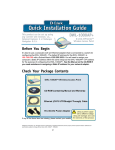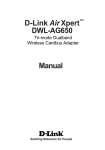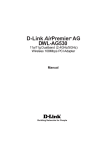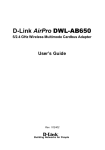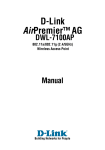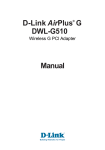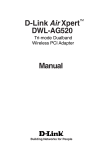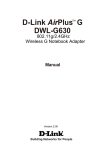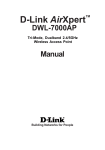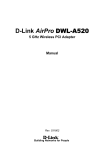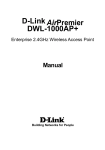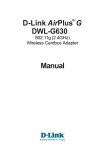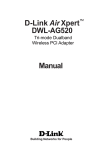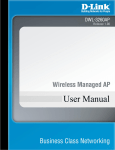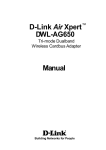Download D-Link AirPro DWL-AB520 Specifications
Transcript
D-Link AirPremier AG DWL-AG660 TM 11a/11g Dualband (2.4GHz/5GHz) Wireless 108Mbps Cardbus Adapter Manual Building Networks for People Contents Package Contents ................................................................................3 Introduction............................................................................................4 Wireless Basics ....................................................................................6 Getting Started ....................................................................................10 Using the Configuration Utility ..............................................................13 Networking Basics ..............................................................................22 Troubleshooting ...................................................................................35 Technical Specifications ......................................................................40 Contacting Technical Support ..............................................................42 Warranty .......................... ...................................................................43 2 Package Contents Contents of Package: D-Link AirPremier AG DWL-AG660 TM 11a/11g Dualband (2.4GHz/5GHz) Wireless 108Mbps Cardbus Adapter Manual, Warranty and Drivers on CD Printed Quick Installation Guide If any of the above items are missing, please contact your reseller. System Requirements for Configuration: A laptop or notebook computer with an available 32-bit cardbus slot Windows XP/2000/Me/98SE At least 128MB of memory and a 500MHz processor An 802.11a, 802.11b or 802.11g access point (for Infrastructure mode) or another 802.11a, 802.11b, or 802.11g wireless adapter (for Ad-Hoc; Peer-to-Peer networking mode). 3 Introduction At up to fifteen times the speed of previous wireless devices (up to 108Mbps in SuperAG mode), you can work faster and more efficiently, increasing productivity. With the DWL-AG660, bandwidth-intensive applications like graphics or multimedia will benefit significantly because large files are able to move across the network quickly. Inclusion of all three standards (802.11g; 802.11a; 802.11b) means that the DWL-AG660 is versatile enough to allow connection to almost any 802.11 network at home, at work or at public hotspots like coffeehouses, airports and hotel lobbies. The DWL-AG660 has the newest, strongest and most advanced security features available today. When used with other 802.11 WPA (Wi-Fi Protected Access) and 802.1X compatible products in a network with a RADIUS server, the security features include: WPA: Wi-Fi Protected Access which authorizes and identifies users based on a secret key that changes automatically at regular intervals. WPA uses TKIP (Temporal Key Integrity Protocol) to change the temporal key every 10,000 packets (a packet is a kind of message transmitted over a network.) This ensures much greater security than the standard WEP security. (By contrast, the previous WEP encryption implementations required the keys to be changed manually.) 802.1X: Authentication which is a first line of defense against intrusion. In the authentication process, the Authentication Server* verifies the identity of the client attempting to connect to the network. Unfamiliar clients would be denied access. For home users that will not incorporate a RADIUS server in their network, the security for the DWL-AG660, used in conjunction with other WPA-compatible 802.11 products, will still be much stronger than ever before. Utilizing the PreShared Key mode of WPA, the DWL-AG660 will obtain a new security key every time it connects to the 802.11 network. You only need to input your encryption information once in the configuration menu. No longer will you have to manually input a new WEP key frequently to ensure security. With the DWLAG660, you will automatically receive a new key every time you connect, vastly increasing the safety of your communication. *Not all servers can provide Authentication 4 Features Faster Wireless Networking with speeds up to 108Mbps in Turbo mode - Faster data transfers mean increased productivity. With the DWL-AG660 in your laptop PC, you will have the flexibility of wireless networking speeds that save you time and money. Compatible with 802.11a, 802.11b and 802.11g Devices - Fully com- patible with the IEEE 802.11a, 802.11b and 802.11g standards, the DWLAG660 can connect with existing 802.11b-, 802.11g- or 802.11a- compliant routers, access points and cards. That means you can still communicate with colleagues and friends while you have the ability to link to even more wireless networks. Better Security with 802.1X and WPA -With the DWL-AG660 in your laptop PC you can securely connect to a wireless network using 802.1X for wireless authentication, as well as WPA (Wi-Fi Protected Access) providing you a much higher level of security for your data and communication than has previously been available. Versatility - The DWL-AG660 is fully compatible with IEEE 802.11a and 802.11b standards, making it interoperable with 802.11a and 802.11b wireless routers and access points in your office, home or at public wireless hotspots. 32-bit Cardbus Performance/Plug & Play Connectivity -The DWL- AG660 is a powerful 32-bit cardbus adapter that installs quickly and easily into laptop PCs, and when used with other D-Link AirPremier TM AG products will automatically connect to the network out of the box. User-friendly configuration and diagnostic utilities LEDs LED stands for Light-Emitting Diode. The DWL-AG660 has the following LEDs: Activity A blinking light indicates data is being transmitted Link A steady light indicates a connection to an access point 5 Wireless Basics D-Link wireless products are based on industry standards to provide easy-touse and compatible high-speed wireless connectivity within your home, business or public access wireless networks. D-Link wireless products will allow you access to the data you want, when and where you want it. You will be able to enjoy the freedom that wireless networking brings. A Wireless Local Area Network (WLAN) is a computer network that transmits and receives data with radio signals instead of wires. WLANs are used increasingly in both home and office environments, and public areas such as airports, coffee shops and universities. Innovative ways to utilize WLAN technology are helping people to work and communicate more efficiently. Increased mobility and the absence of cabling and other fixed infrastructure have proven to be beneficial for many users. Wireless users can use the same applications they use on a wired network. Wireless adapter cards used on laptop and desktop systems support the same protocols as Ethernet adapter cards. 6 Wireless Basics (continued) People use WLAN technology for many different purposes: Mobility – Productivity increases when people have access to data in any location within the operating range of the WLAN. Management decisions based on real-time information can significantly improve worker efficiency. Low Implementation Costs – WLANs are easy to set up, manage, change and relocate. Networks that frequently change can benefit from WLANs ease of implementation. WLANs can operate in locations where installation of wiring may be impractical. Installation and Network Expansion - Installing a WLAN system can be fast and easy and can eliminate the need to pull cable through walls and ceilings. Wireless technology allows the network to go where wires cannot go - even outside the home or office. Inexpensive Solution – Wireless network devices are as competitively priced as conventional Ethernet network devices. Scalability – WLANs can be configured in a variety of ways to meet the needs of specific applications and installations. Configurations are easily changed and range from Peer-to-Peer networks suitable for a small number of users to larger Infrastructure networks to accommodate hundreds or thousands of users, depending on the number of wireless devices deployed. The DWL-AG660 is compatible with the following wireless products: D-Link AirPremier AG DWL-AG530 TM Wireless PCI card used with desktop computers D-Link AirPremier AG DWL-7100AP TM Wireless Access Point D-Link AirPremier AG DI-784 TM Wireless Broadband Router The DWL-AG660 is also interoperable with other 802.11g, 802.11a, and 802.11b standards-compliant devices. 7 Wireless Basics (continued) Standards-Based Technology The DWL-AG660 Wireless Cardbus Adapter utilizes the 802.11a, 802.11b and 802.11g standard. The IEEE 802.11g standard is an extension of the 802.11b standard. It increases the data rate up to 54 Mbps within the 2.4GHz band (108Mbps in Turbo mode.) The 802.11a standard also increases the data rate up to 54 Mbps, but within the 5GHz band. Both 802.11a and 802.11g utilize OFDM technology. This means that in most environments, within the specified range of this device, you will be able to transfer large files quickly or even watch a movie in MPEG format over your network without noticeable delays. This technology works by transmitting high-speed digital data over a radio wave utilizing OFDM (Orthogonal Frequency Division Multiplexing) technology. OFDM works by splitting the radio signal into multiple smaller sub-signals that are then transmitted simultaneously at different frequencies to the receiver. OFDM reduces the amount of crosstalk (interference) in signal transmissions. The D-Link DWL-AG660 will automatically sense the best possible connection speed to ensure the greatest speed and range possible. 802.11g offers the most advanced network security features available today, including: WPA , 802.1x, TKIP, AES and Pre-Shared Key mode. These security features are explained in more detail in the Introduction and the Features section of this manual. The DWL-AG660 is backwards compatible with 802.11b devices. This means that if you have an existing 802.11b network, the devices in that network will be compatible with 802.11g devices at speeds up to 11Mbps in the 2.4GHz range. 8 Wireless Basics (continued) Installation Considerations The D-Link AirPremier AG DWL-AG660 lets you access your network, using a wireless connection, from virtually anywhere within its operating range. Keep in mind, however, that the number, thickness and location of walls, ceilings, or other objects that the wireless signals must pass through, may limit the range. Typical ranges vary depending on the types of materials and background RF (radio frequency) noise in your home or business. The key to maximizing wireless range is to follow these basic guidelines: TM 1 Keep the number of walls and ceilings between the DWL-AG660 and other network devices to a minimum - each wall or ceiling can reduce your DWL-AG660’s range from 3-90 feet (1-30 meters.) Position your devices so that the number of walls or ceilings is minimized. 2 Be aware of the direct line between network devices. A wall that is 1.5 feet thick (.5 meters), at a 45-degree angle appears to be almost 3 feet (1 meter) thick. At a 2-degree angle it looks over 42 feet (14 meters) thick! Position devices so that the signal will travel straight through a wall or ceiling (instead of at an angle) for better reception. 3 Building materials can impede the wireless signal - a solid metal door or aluminum studs may have a negative effect on range. Try to position wireless devices and computers with wireless adapters so that the signal passes through drywall or open doorways and not other materials. 4 Keep your product away (at least 3-6 feet or 1-2 meters) from electrical devices or appliances that generate RF noise. 9 Getting Started There are basically two modes of networking: Infrastructure – using an access point or wireless router such as the DWL-7100AP. Ad-Hoc – directly connecting to another computer, for Peerto-Peer communication, using wireless network adapters on each computer, such as two or more DWL-AG660 Wireless 108Mbps Cardbus Adapters. On the following pages we will show you an example of an Infrastructure Network and an Ad-Hoc Network. An Infrastructure network contains an access point or a wireless router. The Infrastructure Network example shown on the following page contains the following D-Link network devices (your existing network may be comprised of other devices): A wireless router - D-Link AirPremier AG DI-784 A laptop computer with a wireless adapter D-Link AirPremier AG DWL-AG660 A desktop computer with a wireless adapter D-Link AirPremier AG DWL-AG530, D-Link AirPlus Xtreme G DWL-G520, D-Link AirPro DWL-AB520, or D-Link AirPlus DWL-520+ TM TM TM TM A cable modem - D-Link DCM-201 10 Getting Started (continued) Setting up a Wireless Infrastructure Network 1 2 3 7 4 DWL-AG530 DI-784 For a typical wireless setup at home (as shown here), please do the following: 6 5 DWL-AG660 with Laptop PC with Laptop PC You will need broadband Internet access (a Cable or DSL-subscriber line into your home or office). Consult with your Cable or DSL provider for proper installation of the modem. Connect the Cable or DSL modem to your broadband router (see the Quick Installation Guide included with your router). If you are connecting a desktop computer to your network, you can install the D-Link AirPremier TMAG DWL-AG530 Wireless PCI Adapter into an available PCI slot on your desktop computer. You may also install the DWL-A520, DWL-G520 or other compatible D-Link Wireless PCI Adapter. (See the Quick Installation Guide included with the network adapter). Install the D-Link DWL-AG660 Wireless Cardbus Adapter into a laptop computer. (See the Quick Installation Guide included with the DWL-AG660). If you wish, you may connect a computer that is equipped with an Ethernet network adapter (such as a DFE-530TX+) to the router also. A RADIUS server is optional. Connect a RADIUS server to your network to use all the features of WPA. (Without a RADIUS server you can still use the WPA Pre-Shared Key mode.) RADIUS Authentication can also be provided by another service provider over the Internet and remote to your network site. 11 Getting Started (continued) Setting up a Wireless Ad-Hoc Network DWL-AG660 DWL-AG660 Install the D-Link DWL-AG660 Wireless Cardbus Adapter into one laptop computer. (See the Quick Installation Guide included with the product for installation instructions). Install another DWL-AG660 into a laptop computer, or you can install a DWL-AG530 Wireless PCI Adapter into a desktop computer. (See the Quick Installation Guide included with the product). Set the wireless configuration for the adapters to Ad-Hoc mode, set the adapters to the same channel, and assign an IP address to each computer on the Ad-Hoc network. (See box below). IP Address When assigning IP addresses to the computers on the network, please remember that the IP address for each computer must be in the same IP address range as all the computers in the network, and the subnet mask must be exactly the same for all the computers in the network. For example: If the first computer is assigned an IP address of 192.168.0.2 with a subnet mask of 255.255.255.0, then the second computer can be assigned an IP address of 192.168.0.3 with a subnet mask of 255.255.255.0, etc. IMPORTANT: If computers or other devices are assigned the same IP address, one or more of the devices may not be visible on the network. 12 Using the Configuration Utility D-Link AirPremierTM AG DWL-AG660 uses the Configuration Utility as the management software. The utility provides the user an easy interface to change any settings related to the wireless adapter. After you have completed the installation of the DWL-AG660 (refer to the Quick Installation Guide that came with your purchase) whenever you start the computer, the Configuration Utility starts automatically and the system tray icon is loaded in the toolbar (see illustration below*.) Clicking on the utility icon will start the Configuration Utility. Another way to start the Configuration Utility is to click on Start>Programs>D-Link AirPremier TM AG >D-Link AirPremierTM AG Utility. If you are using Windows XP, you can use either the Zero Configuration Utility or the D-Link Configuration Utility. To use the D-Link Configuration Utility with XP, right-click on the wireless network icon in the taskbar in the lower right-hand corner of your computer screen. In the window that appears, select View Available Wireless Networks and click the Advanced button. The screen at right will appear. Select the Wireless Networks tab. Uncheck the box in the properties window that enables windows configuration. To access the WPA security features of the DWL-AG660 you must install the Aegis software (included on the installation CD) before inserting the Adapter into your laptop PC. After you have done this, you can then use the D-Link Configuration Utility with XP by clicking on the D-Link Configuration Utility icon. If the icon does not display in the taskbar, then click on this icon on your desktop to open. 13 *Configuration Utility icon in the system tray Using the Configuration Utility (continued) Link Info Status: Displays the MAC address of the access point that is associated with the DWLAG660. SSID: The Service Set Identifier is the name assigned to the wireless network. The factory SSID setting is set to default. Frequency: The DWL-AG660 is a dualband wireless cardbus adapter. In this instance the 5280MHz indicates that the DWL-AG660 is communicating in the 5GHz band (802.11a). Wireless Mode: Either Infrastructure or Ad-Hoc will be displayed here. Encryption: You can see if WEP is enabled or disabled here. Tx Rate: Tx Rate settings are automatically determined for an optimal speed up to a maximum of 54Mbps. Channel: The channel selection is automatically determined by the DWL-AG660. Link Quality / Signal Strength: Displays the Link Quality for the DWL-AG660 wireless connection to the access point. The Signal Strength represents the wireless signal between the access point and the DWL-AG660. The percentage coincides with the graphical bar. Data Rate: Displays the statistics of data transmitted and received. Rescan: Rescans for the strongest signal in your environment and associates with the access point or router. 14 Using the Configuration Utility (continued) SSID - Service Set Identifier is a name that identifies a wireless network. Access points and wireless devices attempting to connect to a specific WLAN (Wireless Local Area Network) must use the same SSID. The default setting is default. Configuration Wireless Mode - Click on the pull-down menu; select from the following options: Infrastructure Connecting to the WLAN using an access point. (This is the default setting). Ad-Hoc – Wireless mode used when connecting directly to a computer equipped with a wireless adapter in a Peer-to-Peer environment. Ad-Hoc Band - If you have selected Ad-Hoc wireless mode, select the standard for your Ad-Hoc communication: 11b,11g,11a,11a Turbo, or 11g Turbo. Channel – The channel selection is automatically determined by the DWLAG660. In Ad-Hoc mode, the channel must be manually set to the same channel for each wireless adapter. Tx Rate (11b/g) - Tx rates are automatically determined for an optimal speed up to 54Mbps. Tx Rate (11a) - Tx rates are automatically determined for an optimal speed up to 54Mbps. Power Mode – Select from three modes: Continuous Access Mode-this default setting consumes the most power. Maximum Power Save-this setting consumes the least power. Power Save- this setting consumes a moderate amount of power. Preamble -The Preamble defines the length of the CRC block (Cyclic Redundancy Check is a common technique for detecting data transmission errors) for communication between the access point and the wireless network adapters. Note: High network traffic areas should use the shorter preamble type. Support Band - 11B; 11G; 11A; and Super A/G. By default all four choices are selected. You can deselect as many boxes as you wish, leaving at least one box checked. With the site survey tool you can view and connect to the networks in the band or bands that you have selected. 15 Using the Configuration Utility (continued) Encryption > WEP Encryption – WEP is selected here. The other choices are WPA, WPA PSK and None. Authorization mode – choose one of the following modes: Open Authentication – communicates the key across the network. Shared Authentication – allows communication only with other devices with identical WEP settings. Auto – will automatically adjust to the Authentication mode of the wireless client. Default Key - Select one of 4 keys to be the default key. Network Key – enter a key in either ASCII or Hexadecimal format. Key Format - ASCII or Hexadecimal. Hexadecimal digits consist of the numbers 0-9 and the letters A-F. ASCII (American Standard Code for Information Interchange) is a code for representing English letters as numbers from 0-127. Key length - select the key length, either 64- or 128-bits. Click Apply to save the changes. 16 Using the Configuration Utility (continued) Encryption > WPA Encryption – WPA is selected here. The other choices are WEP, WPA PSK, and None. Config – Click Config when WPA is selected. Define Certificate – This pop-up dialog box appears when you select WPA and click Config. Select a Certificate – Select a Certificate from the pull-down menu. Server/Domain Name – Each server has a domain name that uniquely identifies it. That domain name is normally contained in the Subject CN field of the server certificate. A server domain name ends with the name of a larger administrative domain, to which the server belongs. Login Name – enter the Login Name here. Choose a Certificate Authority – Select a Certificate Authority from the pull-down menu. Click OK to complete the WPA configuration. 17 Using the Configuration Utility (continued) Encryption > WPA PSK Encryption – WPA PSK is selected here. The other choices are WEP, WPA, and None. Config – Click Config when WPA PSK is selected. Define WPA PSK – Enter your WPA Passphrase. The minimum length is 8 characters. Click OK to complete the WPA PSK configuration. 18 Using the Configuration Utility (continued) Available Network- The top section of the window displays the Available Networks. Scroll up and down the list and highlight the network to which you wish to connect. Click on the Connect button. Profile- In the lower half of the screen, you can manage the profiles that you have created for the wireless network at home, at the office and in public places. Scroll up and down and highlight the profile that you wish to configure. You can Add or Remove a profile, or configure the Properties of the profile in order to connect with an available network. Refresh- Click on Refresh to get the most updated list of available networks. Site Survey Connect- Highlight an existing network and click Connect and the configuration window on the next page will appear. Signal StrengthTo check the signal strength of a network, scroll to the right in the upper window until the Signal Strength is displayed. Add- Click Add and the screen on the next page will appear. Remove- Highlight a network profile; click Remove to remove a network from the profile list. Properties- Highlight a network profile; click Properties and the screen on the next page will appear. Connect, Add or Properties- When you click on Connect, Add or Properties, the screen on the next page will appear. 19 Using the Configuration Utility (continued) When you click on Connect, Add or Properties in the Site Survey screen this window will appear. You can configure a network in this screen. Just as with the Encryption window shown earlier, you will be prompted to configure the security settings when you make a selection in WPA OPTION. Please see the Encryption section in this chapter for more information about completing WPA security settings. 20 Using the Configuration Utility (continued) About The About screen gives you information about the MAC address and the Utility and Driver Versions of the DWL-AG660. 21 Networking Basics Using the Network Setup Wizard in Windows XP In this section you will learn how to establish a network at home or work, using Microsoft Windows XP. Note: Please refer to websites such as http://www.homenethelp.com and http://www.microsoft.com/windows2000 for information about networking computers using Windows 2000, ME or 98SE. Go to Start>Control Panel>Network Connections Select Set up a home or small office network When this screen appears, click Next. 22 Networking Basics (continued) Please follow all the instructions in this window: Click Next. In the following window, select the best description of your computer. If your computer connects to the Internet through a gateway/router, select the second option as shown. Click Next. 23 Networking Basics (continued) Enter a Computer description and a Computer name (optional.) Click Next. Enter a Workgroup name. All computers on your network should have the same Workgroup name. Click Next. 24 Networking Basics (continued) Please wait while the Network Setup Wizard applies the changes. When the changes are complete, click Next. Please wait while the Network Setup Wizard configures the computer. This may take a few minutes. 25 Networking Basics (continued) In the window below, select the option that fits your needs. In this example, Create a Network Setup Disk has been selected. You will run this disk on each of the computers on your network. Click Next. Insert a disk into the Floppy Disk Drive, in this case drive A. Click Next. 26 Networking Basics (continued) Please read the information under Here’s how in the screen below. After you complete the Network Setup Wizard you will use the Network Setup Disk to run the Network Setup Wizard once on each of the computers on your network. To continue click Next. 27 Networking Basics (continued) Please read the information on this screen, then click Finish to complete the Network Setup Wizard. The new settings will take effect when you restart the computer. Click Yes to restart the computer. You have completed configuring this computer. Next, you will need to run the Network Setup Disk on all the other computers on your network. After running the Network Setup Disk on all your computers, your new wireless network will be ready to use. 28 Networking Basics (continued) Naming your Computer To name your computer, please follow these directions:In Windows XP: Click Start (in the lower left corner of the screen). Right-click on My Computer. Select Properties and click. Select the Computer Name Tab in the System Properties window. You may enter a Computer Description if you wish; this field is optional. To rename the computer and join a domain, click Change. 29 Networking Basics (continued) Naming your Computer In this window, enter the Computer name. Select Workgroup and enter the name of the Workgroup. All computers on your network must have the same Workgroup name. Click OK. Checking the IP Address in Windows XP The wireless adapter-equipped computers in your network must be in the same IP address range (see Getting Started in this manual for a definition of IP address range). To check on the IP address of the adapter, please do the following: Right-click on the Local Area Connection icon in the task bar. Click on Status. 30 Networking Basics (continued) Checking the IP Address in Windows XP This window will appear. Click the Support tab. Click Close. Assigning a Static IP Address in Windows XP/2000 Note: DHCP capable routers will automatically assign IP addresses to the computers on the network, using DHCP (Dynamic Host Configuration Protocol) technology. If you are using a DHCP-capable gateway/router you will not need to assign static IP addresses. If you are not using a DHCP capable router, or you need to assign a static IP address, please follow these instructions: Go to Start. Double-click on Control Panel. 31 Networking Basics (continued) Assigning a Static IP Address in Windows XP/2000 Double-click on Network Connections. Right-click on Local Area Connections. Double-click on Properties. 32 Networking Basics (continued) Assigning a Static IP Address in Windows XP/2000 Click on Internet Protocol (TCP/IP). Click Properties. In the window below, select Use the following IP address. Input your IP address and subnet mask. (The IP addresses on your network must be within the same range. For example, if one computer has an IP address of 192.168.0.2, the other computers should have IP addresses that are sequential, like 192.168.0.3 and 192.168.0.4. The subnet mask must be the same for all the computers on the network). IP Address: e.g., 192.168.0.2 Subnet Mask: 255.255.255.0 Default Gateway: Enter the LAN IP address of the wireless router. (D-Link wireless routers have a LAN IP address of 192.168.0.1). Select Use the following DNS server addresses. Enter the LAN IP address of the wireless router. (D-Link wireless routers have a LAN IP address of 192.168.0.1). Click OK. You have completed the assignment of a static IP address. (You do not need to assign a static IP address if you have a DHCPcapable gateway/router). 33 Networking Basics (continued) Checking the Wireless Connection by Pinging in Windows XP/2000 Go to Start > Run > type cmd. A window similar to this one will appear. Type ping xxx.xxx.xxx.xxx, where xxx is the IP address of the wireless router or access point. A good wireless connection will show four replies from the wireless router or access point, as shown. Checking the Wireless Connection by Pinging in Windows Me /98SE Go to Start > Run > type command. A window similar to this will appear. Type ping xxx.xxx.xxx.xxx where xxx is the IP address of the wireless router or access point. A good wireless connection will show four replies from the wireless router or access point, as shown. 34 Troubleshooting This chapter provides solutions to problems that can occur during the installation and operation of the DWL-AG660. Read the following descriptions if you are having problems. (The examples below are illustrated in Windows XP. If you have a different operating system, the screenshots on your computer will look similar to the following examples). 1. How do I check that the drivers for the DWL-AG660 are installed properly? Go to Start > My Computer > Properties. Select the Hardware Tab. Click Device Manager. 35 Troubleshooting (continued) Double-click on Network adapters. Right-click on D-Link DWL-AG660 Wireless Cardbus Adapter. D-Link AirPremier AG DWL-AG660 D-Link AirPro DWL-AB650 Wireless Cardbus Adapter Select Properties to check that the drivers are installed properly. D-Link AirPremier AG DWL-AG660 Look under Device Status to check that the device is working properly. D-Link AirPremierTM AG DWL-AG660 Tri-mode Dualband Wireless Cardbus Adapter Cardbus Click OK. 36 Troubleshooting (continued) 2. I cannot connect to the access point or the wireless router. Make sure that the SSID on the DWL-AG660 Wireless Cardbus Adapter is exactly the same as the SSID on the access point or wireless router. Move the DWL-AG660 and access point or wireless router into the same room and then test the wireless connection. Disable all security settings. (WEP, MAC Address Control, AES). Make sure that the access point/router are set to the same frequency. Turn off your access point and the computer with the DWL-AG660. Turn on the access point, and then turn on the computer with the DWL-AG660. Refresh the DWL-AG660 Utility. 3. The DWL-AG660 Power and Link lights are not on. Check to see if the DWL-AG660 Cardbus Adapter is firmly inserted into the cardbus slot of your laptop computer. 4. I forgot my Encryption key. Reset the access point to its factory default settings and restore the DWL-AG660 Wireless Cardbus Adapter to the factory default settings. 5. The computer does not recognize the DWL-AG660 Wireless Cardbus Adapter. Make sure that the DWL-AG660 Wireless Cardbus Adapter is properly seated in the computer’s cardbus slot. If Windows does not detect the hardware upon insertion of the adapter, make sure to completely remove drivers that were previously loaded. To remove the drivers, do the following: 37 Troubleshooting (continued) A. Under Tools> select Folder Options…> select View > under Hidden files and folders > select Show hidden files and folders. B. Uncheck Hide extension for known file types > click on Apply. C. Search for previously loaded driver files. Remove these files from the INF and SYSTEM32 (DRIVERS) folders in the Windows directory. Note: Windows XP and Windows 2000 will rename .inf files that have not received WHQL certification into oem.inf files (e.g., oem1.inf). 6. The computer with the DWL-AG660 installed is unable to connect to the wireless network and/or the Internet. Check that the LED indicators for the broadband modem are indicating normal activity. If not, there may be a problem with the broadband connection. Check that the LED indicators on the wireless router are functioning properly. If not, check that the AC power and Ethernet cables are firmly connected. Check that the IP address, subnet mask, gateway, and DNS settings are correctly entered for the network. In Infrastructure mode, make sure the same Service Set Identifier (SSID) is specified on the settings for the wireless clients and access points. The SSID factory default setting for the D-Link products is default. (Double-click on the WLAN icon in the taskbar. The Link Info screen will display the SSID setting). In Ad-Hoc mode, both wireless clients will need to have the same SSID. Please note that it might be necessary to set up one client to establish a BSS (Basic Service Set) and wait briefly before setting up other clients. This prevents several clients from trying to establish a BSS at the same time, which can result in multiple singular BSSs being established, rather than a single BSS with multiple clients associated to it. 38 Troubleshooting (continued) Check that the Network Connection for the wireless client is configured properly. Select AP (Infrastructure) when connecting to an access point and select Ad-Hoc mode when connecting without an access point. Double-click on the WLAN icon in the taskbar > click on Configuration to change the settings for the wireless adapter. If Security is enabled, make sure that the correct encryption keys are entered on both the DWL-AG660 and the access point. Doubleclick on the WLAN icon in the taskbar > click Encryption. Check to see that the key selected is set to the same key as other devices on the network. If Turbo mode is enabled, make sure that Turbo mode is enabled on all Turbo mode compatible devices in your network, in order to communicate. 7. How can I avoid connection problems using the DWL-AG660. Move the DWL-AG660 and access point or wireless router into the same room and then test the wireless connection. Change the channel of the access point. Move devices within the line of sight. 39 Technical Specifications Standards IEEE 802.11 IEEE 802.11a IEEE 802.11b IEEE 802.11g Bus Type 32-bit Cardbus Temperature Operating: 32ºF to 131ºF (0ºC to 55ºC) Humidity: 95% maximum, non-condensing Internal Antenna Type: Dual Antenna Diversity Switching Security: 64-, 128-bit WEP 802.1X WPA - (Wi-Fi Protected Access), 64-,128-bit WEP with TKIP, MIC, IV Expansion, Shared Key Authentication Supports Advanced Encryption Standard (AES) Physical Dimensions: L = 4.64 inches (114.3mm) W = 2.13 inches (54mm) H = 0.34 inches (8.7mm) Weight: 0.12 lb. (55 grams) Warranty: 3 years 40 Technical Specifications (continued) Data Rates: With Automatic Fallback 108Mbps (Turbo Mode); 54Mbps; 48Mbps; 36Mbps; 24Mbps; 18Mbps; 12Mbps; 11Mbps; 9Mbps; 6Mbps; 5.5Mbps; 2Mbps; 1Mbps Media Access Control: CSMA/CA with ACK Frequency Range: 2.4GHz to 2.462GHz 5.150GHz to 5.850GHz Range: Indoors: Up to 328 feet (100 meters) Power Consumption: PowerSave mode = 70mW Standby mode = 1250mW Transmit mode = 1650mW Modulation Technology: Orthogonal Frequency Division Multiplexing (OFDM) Complementary Code Keying (CCK) Direct Sequence Spread Spectrum (DSSS) Receiver Sensitivity: 54Mbps OFDM, 10% PER,-73dBm 48Mbps OFDM, 10% PER,-76dBm 36Mbps OFDM, 10% PER,-82dBm 24Mbps OFDM, 10% PER,-85dBm 18Mbps OFDM, 10% PER,-88dBm 12Mbps OFDM, 10% PER,-89dBm LEDs: Link Activity Transmitter Output Power: 15dBm ± 2dB 41 11Mbps CCK, 8% PER, -91dBm 9Mbps OFDM, 10% PER,-90dBm 6Mbps OFDM, 10% PER,-91dBm 5.5Mbps CCK, 8% PER,-92dBm 2Mbps QPSK, 8% PER,-93dBm 1Mbps BPSK, 8% PER,-94dBm Techni cal Support echnical You can find software updates and user documentation on the D-Link website. D-Link provides free technical support for customers within the United States and within Canada for the duration of the warranty period on this product. U.S. and Canadian customers can contact D-Link Technical Support through our website, or by phone. Tech Support for customers within the United States: D-Link Technical Support over the Telephone: (877) 453-5465 24 hours a day, seven days a week. D-Link Technical Support over the Internet: http://support.dlink.com email:[email protected] Tech Support for customers within Canada: D-Link Technical Support over the Telephone: (800) 361-5265 Monday to Friday 8:30am to 9:00pm EST D-Link Technical Support over the Internet: http://support.dlink.ca email:[email protected] 42 Subject to the terms and conditions set forth herein, D-Link Systems, Inc. (“D-Link”) provides this Limited warranty for its product only to the person or entity that originally purchased the product from: • • D-Link or its authorized reseller or distributor and Products purchased and delivered within the fifty states of the United States, the District of Columbia, U.S. Possessions or Protectorates, U.S. Military Installations, addresses with an APO or FPO. Limited Warranty: D-Link warrants that the hardware portion of the D-Link products described below will be free from material defects in workmanship and materials from the date of original retail purchase of the product, for the period set forth below applicable to the product type (“Warranty Period”), except as otherwise stated herein. 3-Year Limited Warranty for the Product(s) is defined as follows: • • • Hardware (excluding power supplies and fans) Three (3) Years Power Supplies and Fans One (1) Year Spare parts and spare kits Ninety (90) days D-Link’s sole obligation shall be to repair or replace the defective Hardware during the Warranty Period at no charge to the original owner or to refund at D-Link’s sole discretion. Such repair or replacement will be rendered by D-Link at an Authorized D-Link Service Office. The replacement Hardware need not be new or have an identical make, model or part. D-Link may in its sole discretion replace the defective Hardware (or any part thereof) with any reconditioned product that D-Link reasonably determines is substantially equivalent (or superior) in all material respects to the defective Hardware. Repaired or replacement Hardware will be warranted for the remainder of the original Warranty Period from the date of original retail purchase. If a material defect is incapable of correction, or if D-Link determines in its sole discretion that it is not practical to repair or replace the defective Hardware, the price paid by the original purchaser for the defective Hardware will be refunded by D-Link upon return to D-Link of the defective Hardware. All Hardware (or part thereof) that is replaced by D-Link, or for which the purchase price is refunded, shall become the property of D-Link upon replacement or refund. Limited Software Warranty: D-Link warrants that the software portion of the product (“Software”) will substantially conform to D-Link’s then current functional specifications for the Software, as set forth in the applicable documentation, from the date of original retail purchase of the Software for a period of ninety (90) days (“Warranty Period”), provided that the Software is properly installed on approved hardware and operated as contemplated in its documentation. D-Link further warrants that, during the Warranty Period, the magnetic media on which D-Link delivers the Software will be free of physical defects. D-Link’s sole obligation shall be to replace the non-conforming Software (or defective media) with software that substantially conforms to D-Link’s functional specifications for the Software or to refund at D-Link’s sole discretion. Except as otherwise agreed by D-Link in writing, the replacement Software is provided only to the original licensee, and is subject to the terms and conditions of the license granted by D-Link for the Software. Software will be warranted for the remainder of the original Warranty Period from the date or original retail purchase. If a material non-conformance is incapable of correction, or if D-Link determines in its sole discretion that it is not practical to replace the nonconforming Software, the price paid by the original licensee for the non-conforming Software will be refunded by D-Link; provided that the non-conforming Software (and all copies thereof) is first returned to D-Link. The license granted respecting any Software for which a refund is given automatically terminates. Non-Applicability of Warranty: The Limited Warranty provided hereunder for hardware and software of D-Link’s products will not be applied to and does not cover any refurbished product and any product purchased through the inventory clearance or liquidation sale or other sales in which D-Link, the sellers, or the liquidators expressly disclaim their warranty obligation pertaining to the product and in that case, the product is being sold “As-Is” without any warranty whatsoever including, without limitation, the Limited Warranty as described herein, notwithstanding anything stated herein to the contrary. Submitting A Claim: The customer shall return the product to the original purchase point based on its return policy. In case the return policy period has expired and the product is within warranty, the customer shall submit a claim to D-Link as outlined below: • The customer must submit with the product as part of the claim a written description of the Hardware defect or Software nonconformance in sufficient detail to allow D-Link to confirm the same. 43 • The original product owner must obtain a Return Material Authorization (“RMA”) number from the Authorized D-Link Service Office and, if requested, provide written proof of purchase of the product (such as a copy of the dated purchase invoice for the product) before the warranty service is provided. • After an RMA number is issued, the defective product must be packaged securely in the original or other suitable shipping package to ensure that it will not be damaged in transit, and the RMA number must be prominently marked on the outside of the package. Do not include any manuals or accessories in the shipping package. D-Link will only replace the defective portion of the Product and will not ship back any accessories. • The customer is responsible for all in-bound shipping charges to D-Link. No Cash on Delivery (“COD”) is allowed. Products sent COD will either be rejected by D-Link or become the property of D-Link. Products shall be fully insured by the customer. D-Link will not be held responsible for any packages that are lost in transit to D-Link. The repaired or replaced packages will be shipped to the customer via UPS Ground or any common carrier selected by D-Link, with shipping charges prepaid. Expedited shipping is available if shipping charges are prepaid by the customer and upon request. • Return Merchandise Ship-To Address USA: 17595 Mt. Herrmann, Fountain Valley, CA 92708 Canada: 2180 Winston Park Drive, Oakville, ON, L6H 5W1 (Visit http://www.dlink.ca for detailed warranty information within Canada) D-Link may reject or return any product that is not packaged and shipped in strict compliance with the foregoing requirements, or for which an RMA number is not visible from the outside of the package. The product owner agrees to pay D-Link’s reasonable handling and return shipping charges for any product that is not packaged and shipped in accordance with the foregoing requirements, or that is determined by D-Link not to be defective or non-conforming. What Is Not Covered: This limited warranty provided by D-Link does not cover: Products, if in D-Link’s judgment, have been subjected to abuse, accident, alteration, modification, tampering, negligence, misuse, faulty installation, lack of reasonable care, repair or service in any way that is not contemplated in the documentation for the product, or if the model or serial number has been altered, tampered with, defaced or removed; Initial installation, installation and removal of the product for repair, and shipping costs; Operational adjustments covered in the operating manual for the product, and normal maintenance; Damage that occurs in shipment, due to act of God, failures due to power surge, and cosmetic damage; Any hardware, software, firmware or other products or services provided by anyone other than DLink; Products that have been purchased from inventory clearance or liquidation sales or other sales in which D-Link, the sellers, or the liquidators expressly disclaim their warranty obligation pertaining to the product. Repair by anyone other than D-Link or an Authorized D-Link Service Office will void this Warranty. Disclaimer of Other Warranties: EXCEPT FOR THE LIMITED WARRANTY SPECIFIED HEREIN, THE PRODUCT IS PROVIDED “AS-IS” WITHOUT ANY WARRANTY OF ANY KIND WHATSOEVER INCLUDING, WITHOUT LIMITATION, ANY WARRANTY OF MERCHANTABILITY, FITNESS FOR A PARTICULAR PURPOSE AND NON-INFRINGEMENT. IF ANY IMPLIED WARRANTY CANNOT BE DISCLAIMED IN ANY TERRITORY WHERE A PRODUCT IS SOLD, THE DURATION OF SUCH IMPLIED WARRANTY SHALL BE LIMITED TO NINETY (90) DAYS. EXCEPT AS EXPRESSLY COVERED UNDER THE LIMITED WARRANTY PROVIDED HEREIN, THE ENTIRE RISK AS TO THE QUALITY, SELECTION AND PERFORMANCE OF THE PRODUCT IS WITH THE PURCHASER OF THE PRODUCT. Limitation of Liability: TO THE MAXIMUM EXTENT PERMITTED BY LAW, D-LINK IS NOT LIABLE UNDER ANY CONTRACT, NEGLIGENCE, STRICT LIABILITY OR OTHER LEGAL OR EQUITABLE THEORY FOR ANY LOSS OF USE OF THE PRODUCT, INCONVENIENCE OR DAMAGES OF ANY CHARACTER, WHETHER DIRECT, SPECIAL, INCIDENTAL OR CONSEQUENTIAL (INCLUDING, BUT NOT LIMITED TO, DAMAGES FOR LOSS OF GOODWILL, LOSS OF REVENUE OR PROFIT, WORK STOPPAGE, COMPUTER FAILURE OR MALFUNCTION, FAILURE OF OTHER EQUIPMENT OR COMPUTER PROGRAMS TO WHICH DLINK’S PRODUCT IS CONNECTED WITH, LOSS OF INFORMATION OR DATA CONTAINED IN, STORED ON, OR INTEGRATED WITH ANY PRODUCT RETURNED TO D-LINK FOR WARRANTY SERVICE) RESULTING FROM THE USE OF THE PRODUCT, RELATING TO WARRANTY SERVICE, OR ARISING OUT OF ANY BREACH OF THIS LIMITED WARRANTY, EVEN IF D-LINK HAS BEEN ADVISED OF THE POSSIBILITY OF SUCH DAMAGES. THE SOLE REMEDY FOR A BREACH OF THE FOREGOING LIMITED WARRANTY IS REPAIR, REPLACEMENT OR REFUND OF THE DEFECTIVE OR NON-CONFORMING PRODUCT. THE MAXIMUM LIABILITY OF D-LINK UNDER THIS WARRANTY IS LIMITED TO THE PURCHASE PRICE OF THE PRODUCT COVERED BY THE WARRANTY. THE FOREGOING EXPRESS WRITTEN WARRANTIES AND REMEDIES ARE EXCLUSIVE AND ARE IN LIEU OF ANY OTHER WARRANTIES OR REMEDIES, EXPRESS, IMPLIED OR STATUTORY. 44 Governing Law: This Limited Warranty shall be governed by the laws of the State of California. Some states do not allow exclusion or limitation of incidental or consequential damages, or limitations on how long an implied warranty lasts, so the foregoing limitations and exclusions may not apply. This limited warranty provides specific legal rights and the product owner may also have other rights which vary from state to state. Trademarks: D-Link is a registered trademark of D-Link Systems, Inc. Other trademarks or registered trademarks are the property of their respective manufacturers or owners. Copyright Statement: No part of this publication or documentation accompanying this Product may be reproduced in any form or by any means or used to make any derivative such as translation, transformation, or adaptation without permission from D-Link Corporation/D-Link Systems, Inc., as stipulated by the United States Copyright Act of 1976. Contents are subject to change without prior notice. Copyright© 2002 by D-Link Corporation/D-Link Systems, Inc. All rights reserved. CE Mark Warning: This is a Class B product. In a domestic environment, this product may cause radio interference, in which case the user may be required to take adequate measures. FCC Statement: This equipment has been tested and found to comply with the limits for a Class B digital device, pursuant to part 15 of the FCC Rules. These limits are designed to provide reasonable protection against harmful interference in a residential installation. This equipment generates, uses, and can radiate radio frequency energy and, if not installed and used in accordance with the instructions, may cause harmful interference to radio communication. However, there is no guarantee that interference will not occur in a particular installation. If this equipment does cause harmful interference to radio or television reception, which can be determined by turning the equipment off and on, the user is encouraged to try to correct the interference by one or more of the following measures: • • • • Reorient or relocate the receiving antenna. Increase the separation between the equipment and receiver. Connect the equipment into an outlet on a circuit different from that to which the receiver is connected. Consult the dealer or an experienced radio/TV technician for help. For detailed warranty outside the United States, please contact corresponding local D-Link office. Register your D-Link product online at http://support.dlink.com/register/ (10/15/04) 45













































